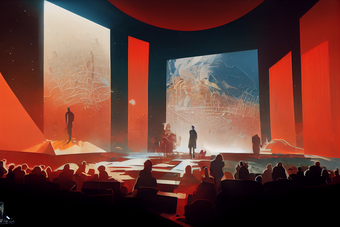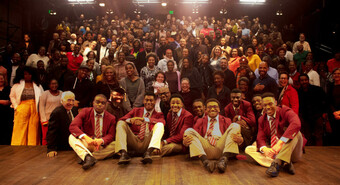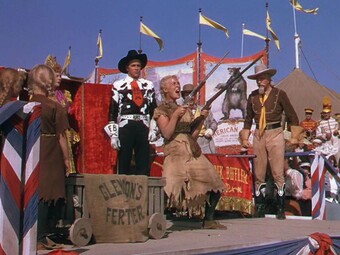The Guns in My Plays
After the shootings at Sandy Hook Elementary School, I felt like I’d felt after 9/11: grief stricken, traumatized and voiceless. In all the categories I fall in: woman, mother, playwright, human being, the events of that day, remain unbearable. The blessing and the curse of the writer is her imagination. At every mention and at random moments of every day in those first few weeks, I would begin to imagine what occurred in those classrooms, what was waiting for the first responders, and for those children’s parents.
Even now, I have to harden my heart to put these words onto paper. While I avoided most of the news on cable, I did venture onto Facebook where I discovered some of my “friends” were anti gun control. I do not understand this position, so I started reading (and posting) all the articles I could find on gun legislation. I read some very cogent, practical and common sense articles like New York Times columnist, Nicholas Kristof’s, op-ed. Then I read Porochista Khakpour’s essay, “Why Did Nancy Lanza Love Guns?” In it, she describes her personal journey of love and obsession and ultimately rejection of guns: guns made her feel safe, guns made her feel powerful, guns were sexy, guns were fun. I met Khakpour when we were both fellows at the Sewanee Writers Conference in 2008. I see her standing at the podium, tall and beautiful, throwing back her long dark hair as she read from her novel with a mischievous and joyful spirit, and now I can imagine her shooting a gun.
I have never owned a gun, never touched a gun, never even ever seen a real gun. I don’t share Khakpour’s obsession, but the characters in my plays do. Not in all of them—just the most successful ones, the ones that have been sanctioned by the powers that be as “good,” the plays that receive professional development, multiple productions, get published, and win awards. In each one of those plays a character either has a gun, shoots a gun, is threatened by a gun, threatens someone else with a gun, is afraid of guns, or is somehow traumatized by the violence of a gun. This is a deeply disturbing revelation for me for several reasons. Firstly, I don’t think of myself as writing about guns. I think I’m writing about family, communication, the power of forgiveness and healing. But the presence of guns in my writing is undeniable.
Not in all of them—just the most successful ones, the ones that have been sanctioned by the powers that be as “good,” the plays that receive professional development, multiple productions, get published, and win awards.
In my first play Pig, written straight out of grad school, a troubled sailor goes AWOL and takes his family hostage. He shoots his neighbor’s dog (which was for audiences the most disturbing thing that happens) shoots his uncle and them himself. (note: I called it a comedy, okay, a black comedy) At the first talkback an audience member expressed disbelief that I’d written this play. The moderator chimed in, “Seriously, you look like you’d write something like Mary Poppins, where did this come from?” To be fair, at the time, even at thirty, I did look like I was twelve years old, but I was offended by the implication that a woman, even a seemingly innocent young woman couldn’t write a play with what I then imagined as real world action in it. I wasn’t going to be put in that woman ghetto box, thank you very much.
After giving birth to my first daughter, my plays began to evolve. I knew I’d write different kinds of plays from that point on, and no matter how dark I’d go, always strive to “reach for the light.” But, the guns kept coming back, emerging seemingly organically in play after play. Now, I am not a careful planner of my career. My ideas show up like orphaned babies on my doorstep that cry out in the cold until I cave in and let them in. Besides guns, there is also a lot of war (often as backdrop): the First Gulf War, Bosnia, the Hundred Years War, Sudan, Iraq. Once early in my career, my mother asked me, “Why don’t you write happy plays?" I answered, “I don’t choose these subjects, they choose me.” I do enforce some practical parameters, like maybe don’t put eleven characters in your plays unless you can double, but do I ever think, even subconsciously: better put a gun in your play if you want this one to get produced? Isn’t there always an exchange, a feedback loop between artist and potential producer?

The fact remains that it is my most commercially successful plays that are the ones with the guns. Marsha Norman said something to this effect in her article “Not There Yet.” Says Norman, “People like the plays in which the women act like guys, talk like guys, wave guns around and threaten to kill each other…The critics have liked my “guy” plays—the ones with guns in them—and pretty much trashed the rest.” I’m not advocating for self-censorship. I’m not saying never write about guns or violence, since writing about it is a way of standing up against it. As a student of mine said recently, “There are three hundred million guns in this country. We are clearly a gun culture. How can art not reflect that?”
My husband is a good, gentle and kind man and his favorite movie is Pulp Fiction. Whenever it is on television (which is actually very often) he will stay up until two in the morning watching it again and again. “It’s funny,” he says. Is violence different when it’s combined with humor? Does it make it more palpable? Or does it desensitize? I once wanted to walk out of a production The Lieutenant of Inishman because I found the combination of butchery and comedy too much to take. Is it a matter of degree? I know I probably won’t stop writing about violence in my work despite these questions I have. In my current play, Soldier’s Heart, a mother points a gun at her own child. It’s integral to the action, to the theme and the whole point of the play. I’m not going to take that gun out of her hands. Despite Chekhov’s rule, though, the gun does not go off, so maybe that’s progress?
Is violence different when it’s combined with humor? Does it make it more palpable? Or does it desensitize?
At Point Park University where I teach, the Cinema and Digital Arts Department has a “no weapons” policy for its Introduction to Screenwriting and early production classes. It is explained as a way of providing parameters for screenplay assignments, but it also addresses a “production and liability/risk management issue,” according to chair and screenwriter, Nelson Chipman. “With such prevalence of weapons in current fictional shows, reality, news and gaming we look for ways to help students create work that is more ingenuous, creative…tasked with creating a story without any weapons…students create more meaningful work, and actually get much more creative with violence and its repercussions.” My students balked at this rule at first and found myriad ways to hide all manner of weapons in their scripts, reminding me of a story a friend told me about her toddler, who faced with his mother’s strict no toy gun policy, bit his peanut butter sandwiches into the shape of pistols. But my insistence (points off for weapons) led them to discover that while guns can easily complicate a moment, create tension, lead to their climax, shock an audience, they are not necessary to good storytelling and in fact can limit the deep, surprising, complex and original conflicts that emerge in their work, finally. Without the guns, they were forced to imagine something new.
I read somewhere that after we dropped the bomb on Hiroshima, Bertolt Brecht went back and revised the plays that came before. He felt it wasn’t the same world anymore, and that his plays, even the ones already written had to reflect that new reality. The massacre at Sandy Hook Elementary has done that to me: it’s altered my view of reality. I’m not Bertolt Brecht, so I won’t be revising those plays with guns in them, but going forward I’m going to be more mindful of what Brecht also said: “Art is not a mirror with which to reflect reality, but a hammer with which to shape it.” The gift of imagination that the writer has been blessed with is sometimes a curse, but it can also be a tool. We as writers can reflect society or reshape it, but we also have the opportunity to more completely re-imagine it. And in that re-imagination, I believe, lies all of our hopes.








Comments
The article is just the start of the conversation—we want to know what you think about this subject, too! HowlRound is a space for knowledge-sharing, and we welcome spirited, thoughtful, and on-topic dialogue. Find our full comments policy here
Donna Hoke: This is fascinating. I have two plays out of 18 with brief gun use, and one is my very latest that nobody's even seen yet, and the gun is not used for conflict. The other is the one that's been produced three times and never even had a reading--ironically, in England and Ireland. On the other hand, ALL my plays have sex, so...
Thank you Tammy for your thoughtful reflection. I am not a writer, even so, this gives me "food for thought" about the choices I make in my consumption of stories, plays and media.
My personal ethic for including guns in my plays (as I have several times and expect to do again) is that I must pretty clearly show that they hurt people badly and kill people, and that the person brandishing the gun isn't awesome and badass for doing so. I feel a personal responsibility to connect their use directly with strongly depicted, irreversible suffering. In a way I'm a hypocrite, because I watch a LOT of action movies that fall short of this.
Twice in my life I've been threatened at gun point. I've written about it in my work without a single gun or mention of a gun. Metaphor does the violent job better than if I'd actually had a gun onstage pointed at the character of me. My first play has a gun in it, but I chalk that up to the immaturity that comes with a first play. Since then I've found more imaginative ways to heighten the circumstances. I do believe in censoring yourself when it comes to this issue. Censorship isn't always a bad thing; sometimes it is you using your taste and craft and greater imagination. If there's a joke in our play that you've seen or heard one too many times, you have no problem taking it out. Well guns in the theater have become an overused joke. I find it sad and telling that Brecht chose the hammer as his tool for shaping. I'm in a Brecht play right now. He didn't use a hammer. He used fingers, ideas, quirky German humor, rearranged theatrical tropes, and questions to shape the world. But then he pathetically chose to act like a tough guy in his revolutionary statement and say he was using a hammer. The era of the tough guy is over. Let them slide down, with their greasy Brylcreem fingers, into a landfill of destructive instruments. Let them stay down there until they're willing to grow up and grow something new.
I believe too that Art both reflects and shapes our social reality. HOW we use those semantically loaded props ( guns, cigarettes etc) matters as much if not more than using them. Thank you for the discussion. Is not HOW we portray people as important or may be more important as our decision to portray them?
This is something I've noticed in theater -- firing of a gun for dramatic effect. I find my heart racing in the closed theater with my fingers in my ear, totally missing any dialogue leading up to the gun shot. I'm revisiting these questions as I revisit a play I wrote about Ida B. Wells, a journalist who was compelled to carry a firearm while investigating lynching in the U.S. This is a fact of her life. I don't think she ever fired it. The pen was mightier than the gun.
So thoughtful- thanks, tammy. maks me think of what a friend, Jessica Thebus, often says- more and more now, she looks for the capacity of healing, somewhere in the play ,for her to want to take the time and energy to work deeply with and on it...doesn't mean no guns, as you say. But creating vs destroying as a litmus test for what a story is aiming at...your essay makes me think about that as well...
Thank you MIchael. Yes, I agree, what's the point, if we're not moving towards healing of some kind.
Did Dustin Hoffman mean stage plays? because he has used a gun in multiple roles- straw dogs, marathon man (where he points a gun at the audience).
I agree with most of the sentiments in this article. As a playwright who sometimes writes violent plays, i have to ask myself what it all serves. What I have a hard time with is the old writer mantra of " I don't chose my play subjects, they chose me"- that's a cop out. While they may appear on your doorstep like orphans as you say, you have to make the conscious decision whether to invite them in and give them food or locking the door. Insisting that you aren't merely a writer with curiosity, but some kind of hocus pocus "medium" who is spoken to from the ether shifts the responsibility of the work away from you. I think the real question is -is the gun a prop- used as other props, or is it simply a device. While not the proper definition of prop, I think this gets to the heart of it- Noun
A pole or beam used as a support or to keep something in position, typically not an integral part of the thing supported. Is the gun supporting an idea, or is it simply sitting in the room to prop up a weak idea?
I heard Dustin Hoffman say in an NPR interview that has never and will never hold a gun for a part he played. He said it was because a gun is a boring choice. I would like to think I would never write a part that Dustin Hoffman would refuse to play or tell me I made boring choices. I've written a lot of plays with guns in the past. I've had English theatre people tell me they can identify an American play by the number of guns in them. I don't think you could do Hedda Gabbler without a gun... but in general, I am pledging to try to make my plays more interesting than that particular choice of prop. Thanks for this article, I am definitely going to include a discussion of this topic in future classes with my students.
As I recall a 1911 .45ACP handgun played an important role in Marathon Man's final scene. And Dustin was holding it.
I never use guns in my plays. I guess I'd rather stab people! Great meditation on this subject, Tammy. For me the use of violence in my plays actually comes from, oh! perhaps the same place that violence comes from: I'm afraid I won't be able to get the job done, make my point, get people to pay attention. There's that saying- "I get it! You don't have to hit me over the head with it!" Maybe a rewrite should go- "I get it! You don't have to wave a gun in my face!" -your biggest fan, Rob C
I found this article very moving. I identified sincerely with what you said on so many levels. Especially concerning my personal use of violence and war in my plays. It's at the heart of my artistic voice as a writer and thus in about every piece I've written... I love to explore how our culture breeds violence. I want the audience to face our morbid love affair with sadness, violence and pain. To look at what we do to one another and question if its building is up or tearing us apart. I think art can be a mirror...whether it's a funny house or magnifying mirror... I am not sure. But, I do believe that the bigger question here goes beyond just guns or no guns.
This is a fascinating and ultimately timely post for me. I just today closed the world premiere of my play "Henry Moore is Melting", which includes several guns. I had never really thought about the implications of my putting them in the play - even in the wake of Sandy Hook. Then again, the play attempts to offer some hope (though fleeting) of escaping a life of violence and criminality. So, what becomes more important then - excluding guns in hopes of presenting a world as we'd like to see it, or including them as part of a greater conversation about other ways to live?